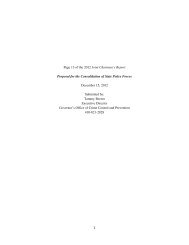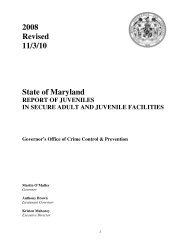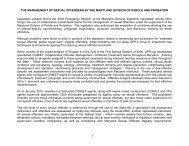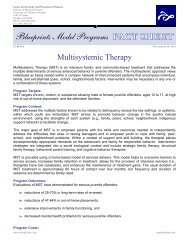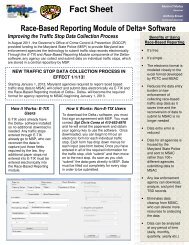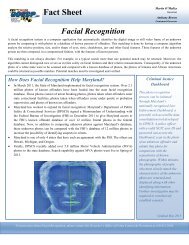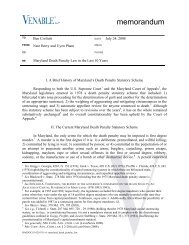Targeted Outreach - Governor's Office of Crime Control & Prevention ...
Targeted Outreach - Governor's Office of Crime Control & Prevention ...
Targeted Outreach - Governor's Office of Crime Control & Prevention ...
You also want an ePaper? Increase the reach of your titles
YUMPU automatically turns print PDFs into web optimized ePapers that Google loves.
Appendices 53<br />
All youth are immediately assigned a Guardian Angel (GA)<br />
to act as their case manager. Any staff person can be a GA.<br />
They are assigned to youth by the program directors,<br />
based on availability <strong>of</strong> staff.<br />
The two program directors are responsible for filling out<br />
the intake and tracking forms at their respective Clubs.<br />
They gather information to complete the documentation<br />
from the youth’s GA and from probation.<br />
Programming<br />
The content <strong>of</strong> FtF programming is provided largely by<br />
Club staff, but two outside organizations’ representatives<br />
also contribute. The Club provides homework assistance;<br />
computer lab time; a Guardian Angel; case management<br />
(by the Club director); Smart Moves; Teens, <strong>Crime</strong> and the<br />
Community (a Club course); a team building project; and<br />
videos and discussion groups.<br />
The Westside Family Coalition provides staff who teach<br />
Anger Management/Conflict Resolution and Job Smart,<br />
an outreach program for at-risk youth. Job Smart includes<br />
job development, job counseling, job search training and<br />
job preparation. The curriculum covers resume writing,<br />
networking and self-esteem building.<br />
Police, probation and Club staff all track the progress and<br />
attendance <strong>of</strong> the youth, and all attend the youth’s orientation<br />
and “graduation” ceremonies.<br />
Changes to the Club to accommodate the initiative<br />
Program directors reported that few changes were necessary<br />
to make regular Club programming accommodate<br />
FtF, because FtF operates in the evenings when the Clubs<br />
are open only to teens. With no younger kids around,<br />
there are fewer safety issues or concerns. In addition,<br />
although there are a few times when FtF kids participated<br />
in regular Club activities, most <strong>of</strong> their time was spent separate<br />
from regular members. Finally, there were fewer than<br />
five youth involved in any one session, so their presence<br />
was not considered problematic for the other Club youth.<br />
Two changes that the Club made were the use <strong>of</strong> Guardian<br />
Angels with the FtF youth, and giving Club staff increased<br />
access to probation and police personnel through their<br />
personal beepers.<br />
Boys & Girls Club <strong>of</strong> St. Paul: “Getting Out”<br />
Program Overview<br />
The Getting Out Program is a collaborative effort <strong>of</strong> the<br />
Boys & Girls Clubs <strong>of</strong> St. Paul and the St. Paul Police<br />
Department. The program <strong>of</strong>fers free tattoo removal to<br />
gang involved youth when they commit to leaving their<br />
gang and taking other steps toward changing their lives.<br />
Tattoo removal is critical for youth who want to leave<br />
gangs because tattoos can be an external marker <strong>of</strong> gang<br />
involvement. Employers or other gang members may continue<br />
to mistake a youth as a gang member as long as they<br />
retain their tattoo. In order to qualify for monthly treatments,<br />
youth are required to put in 20 hours <strong>of</strong> community<br />
service each month and work with a case manager to<br />
attain their personal goals.<br />
The program has five main components: community service,<br />
education, job skills, life skills and recreation. Unlike<br />
other Boys & Girls Clubs initiatives, it is not a facility-based<br />
program. The program hinges on the relationship developed<br />
between a youth and one case manager. Youth are<br />
assigned to one case worker who helps them set goals and<br />
find the resources, either within or outside the Club, to<br />
achieve those goals. As a result, many <strong>of</strong> the Getting Out<br />
youth did not visit the Boys & Girls Club.<br />
Goals<br />
The primary goal <strong>of</strong> the initiative is to create a network <strong>of</strong><br />
services that will support youth attempting to get out <strong>of</strong><br />
gangs. Specifically, the goals are as follows:<br />
• Establish a referral network that will enable the Club<br />
to identify 35 youth who have expressed interest in<br />
getting out <strong>of</strong> gangs;<br />
• Build a network <strong>of</strong> service providers who will assist<br />
gang-involved youth in meeting their needs;<br />
• Establish a case management system to track participant<br />
progress in achieving personal goals in community<br />
service, education, job skills, life skills, and<br />
positive peer interactions; and<br />
• Create a mechanism to remove gang-related tattoos<br />
as participants show satisfactory progress toward<br />
meeting their goals.<br />
Gangs in St. Paul<br />
At the time <strong>of</strong> our research, the Twin Cities had a unique<br />
and pervasive gang problem. Its Midwestern location and<br />
proximity to Chicago and Detroit had led to the infiltration<br />
<strong>of</strong> prominent national gangs including Bloods, Crips,<br />
Disciples, Latin Kings and Vice Lords. Some <strong>of</strong> these gangs<br />
had been recruiting in the Twin Cities since the 1970s and<br />
were known to be involved in drug distribution. They had<br />
also been responsible for several homicides, including<br />
those <strong>of</strong> police <strong>of</strong>ficers. Newer local gangs, particularly<br />
Southeast Asian gangs, had also begun to form. These<br />
gangs were thought to be more territorial in nature and<br />
focused on the protection <strong>of</strong> members in their group. At<br />
the time <strong>of</strong> our research, Asian gangs had not been<br />
involved in serious shooting or homicide incidents, but<br />
were becoming well-armed. Other local or neighborhood<br />
gangs were also constantly evolving.



